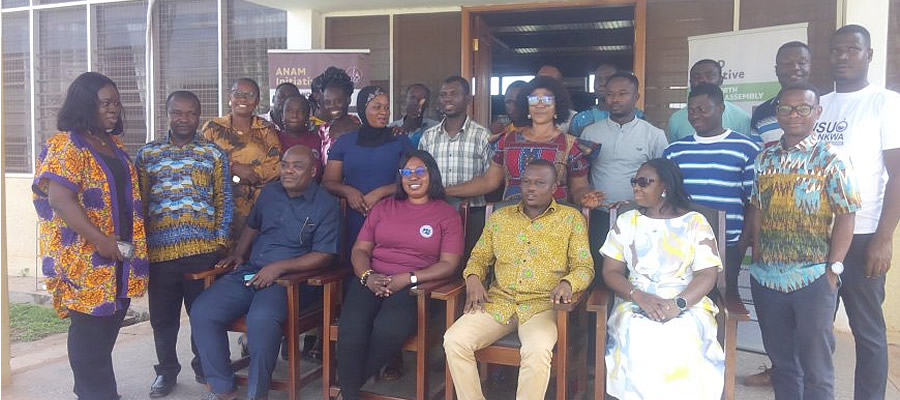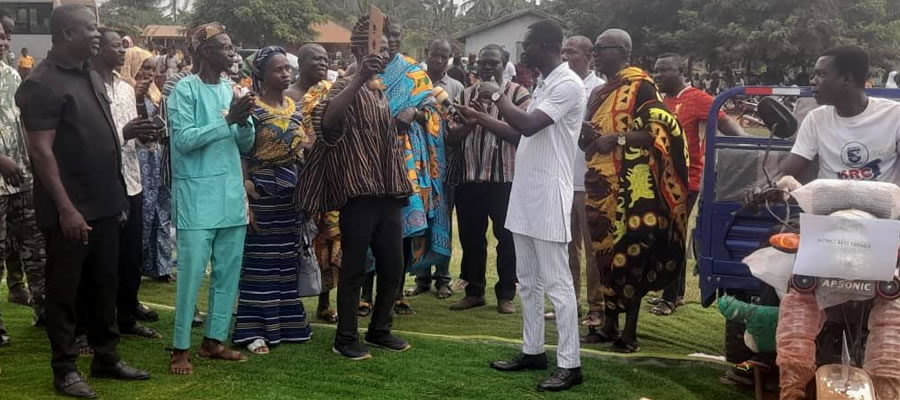

Transport Services
Public road transport services are provided by the Ghana Private Road Transport Union (GPRTU), Progressive Transport Owners Association (PROTOA), and other splinter transportation groups of the Trades Union Congress (TUC). These Unions have branches scattered in major communities within the District. Their services are provided with cargo trucks, mini-trucks, mini-buses and taxis.
Due to the poor nature of roads, road transport service providers complain of high vehicle operation costs due to regular breakdown of their vehicles. Part of the high cost is transferred to the passengers in the form of high transport fares especially on roads to remote areas like Goamu, Gambia and surroundings communities.
Service and Commerce
The main commercial activity in the District is buying and selling of agricultural and manufactured (industrial) goods. This forms an important activity to the people of the District. The major marketing centres in the District are Kenyasi, Gambia No. 2 and Ntotroso, Traders are mostly retailers who buy on market days and in turn sell it during non-market days.
Some of the agricultural goods that are traded include yams, plantain, cassava, fruits such as pea and oranges, cereals such as maize and rice. Industrial goods that are traded in are farm implements, plastics, footwear, textiles, used clothing, provisions and other manufactured goods. These goods are brought into the market centers from places such as Kumasi, Goaso, Tepa, and Sunyani.
Mining
The economic or investment potentials of Newmont Ghana Gold Limited, Ahafo Mine at Kenyasi, the District capital has opened up the area to people. The project was initiated in 2004 with exploration in 2005. The full operation of the gold mining activities which started a decade ago is having a greater impact on development as jobs have been created, revenue generated to the Assembly and social responsibility is being undertaken in these areas to complement the effort of the Assembly in the provision of basic services such as school blocks and water facilities. Again, the provision of alternative livelihood jobs in the catchment areas has also helped to create jobs and diversify the local economy. There are also activities of small- scale mining operators in these gold deposited areas which is a source of worry to the people although it serves as employment to the people.
The activities of these mines would be closely monitored to avoid any environmental hazards caused by their operations.
Manufacturing
The Manufacturing sector is one of the fastest growing local economy which employs 5.7%. The District can boast of small scale or ago-based industries like palm oil extraction, ‘gari’ processing, mechanical workshops, and a host of others in many other communities. There are other small-scale sectors such as wood-based industries (carpentry), metal works, block moulding and metal-based industries are mostly blacksmithing which are scattered in the District.
Apart from relying on unpaid apprentices, entrepreneurs in these industries employ few people to facilitate the production processes. The average size of small scale manufacturing in terms of members is about three people and in the case of medium scale, it is about ten people in the District.
Labour-intensive methods are used by entrepreneurs in most of the production processes, except in some few cases where chemical (petrol, diesel) and electric energies are used.
Through various interventions, the drudgery associated with Gari production has been eliminated in some pilot communities through the supply of gari processing machines. Most production processes are financed through personal savings and support from relatives and friends. The main problems inhibiting the growth of the manufacturing industries are access to credit; small market size for products. In spite of the factors militating against growth in the sectors, manufacturing industries have the prospects to:
- Generate employment and improving income level for the rural people
- Utilise local raw materials and thereby provide market for agricultural produce
- Improve growth and development.
The sector must be encouraged to play a more meaningful role in the District Economy.
Construction
The construction sector in the District has seen a little improvement for decade or the past. The discovery of gold in the District coupled with increase in migration trends has boosted the construction industry. Construction works such as private houses, hotels, fuel stations along Kenyasi-Kumasi roads and a block laying factory are springing up. The high cost of building materials and high labour cost is seriously affecting this sub-sector. Despite this constraint the construction sector is one of the sub-sectors in terms of the attraction of jobs for the youth and the unemployed. The improvement in this sub-sector is likely to improve the incomes of the youth and improve the revenue base of the Assembly through property rate payment.
Energy
The District energy sources are analysed on the basis of electricity, fuel wood, petroleum products such as petrol, diesel oil and liquefied petroleum gas, solar, flashlights/torch and so on. It is estimated that 47.7% of the inhabitants now enjoy electricity from the National grid. This is due to the Government policy of the Rural Electrification Project known as Self Help Electrification Projects (SHEP).There are still quite a number of communities in the District that have not been connected to the National grid and others are yet to be connected to the National grid.
The major problem facing the District electricity production is the intermittent and unreliable nature of the power supply which affects production activities. With the improved economic activities and massive expansion and development springing up in the District, it has become necessary for the District to own its own sub-station to ensure regular supply of electricity.
Fuel wood and charcoal continue to be a major source of energy supply for cooking for the people in the District. The environmental threat caused by the cutting down of these trees and their effect on the depletion of the environment continue to be of great concern to the assembly.
Access to Energy/Utilities and Household Facilities
As shown in table 1.23, the three main sources of lighting for households are electricity (main) (47.6%), flashlight (42.6%) and kerosene lamp (8.2%).The proportion of dwelling units using electricity generators as the main source of lighting is under one percent (0.4%). Eighty point eight percent (80.8%) of urban dwelling units use electricity as the main source of lighting. In rural areas, the proportion using electricity is 29.7 percent. It again shows that, whiles only 12.5 percent of dwelling units in urban areas use flashlight as the main source of light, about 6 in ten dwelling units (58.9 %) do so in rural localities.
Main Source of Energy in the District
Electricity (main) (47.6 %) is the most commonly used source of light by households in the District followed by flashlight/ torch with 42.6 percent. The rest of the lighting source constitutes not more than 10 percent.
Date Created : 11/15/2017 2:32:55 AM












 facebook
facebook
 twitter
twitter
 Youtube
Youtube
 +233 593 831 280
+233 593 831 280 0800 430 430
0800 430 430 GPS: GE-231-4383
GPS: GE-231-4383 info@ghanadistricts.com
info@ghanadistricts.com Box GP1044, Accra, Ghana
Box GP1044, Accra, Ghana